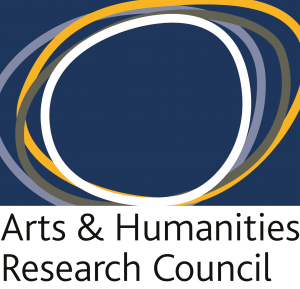From Glossopoly to Dourgoutopoly: affect, flows and co-creating localities
Projects and conceptual frameworks
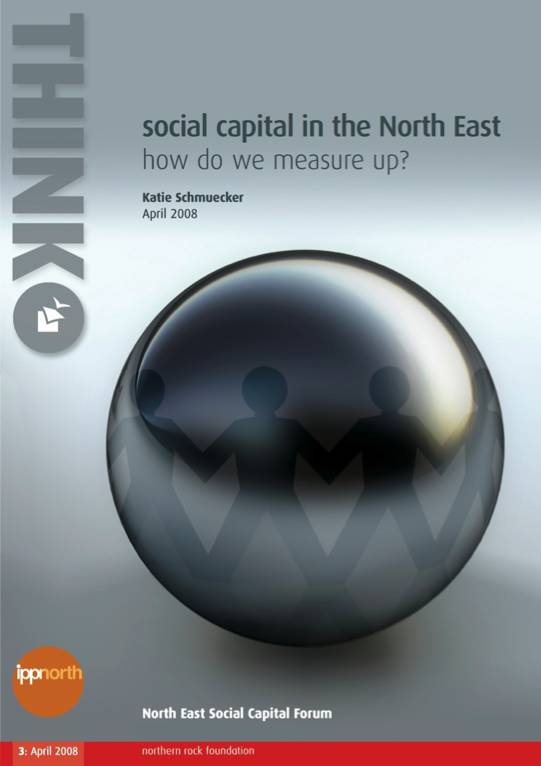
Figure 01
Across a range of fields of policy, practice and theory “a language of assets” (O’Leary et al, 2011, p. 6) is emerging. Whilst often traced, particularly in the North American context, to the concept of ‘asset-based community development’ or ABCD as outlined Kretzmann and McKnight (1993), asset based theories, strategies and methods can be seen to have a much longer and more diverse trajectory of development and application. It is also important to recognize that a critique of asset based theorisations is beginning to emerge (e.g. Emejulu, 2013; MacLeod and Emejulu, forthcoming), although arguably both the development and critique of asset-based approaches is hampered by the diversity and flexibility of the concept which, like many other concepts currently circulating in the area of social policy and community development, “mean both more and less” than is widely appreciated (Levitas, 2004, p. 41).
The promise and pitfalls of a language of assets is well demonstrated in the AHRS’s Connected Communities programme, and in my involvement in this programme. The language of assets has been formally adopted in two Connected Communities projects I have been a co-investigator on – namely Unearthing Hidden Assets (AH/K006541/1) and Co-designing Asset Mapping (AH/L013363/1) – but can also be seen to be applicable to a range of other projects, including Affect, affordance and connecting rural and urban communities (AH/I507736/1), Untold stories of volunteering (AH/K006576/1)), Revisiting the mid-point of British communities: a study of affect, affordance and connectivity in Glossop (AH/J006920/1), Ladders to the cloud (AH/J006734/1) and Community Web2.0: creative control through hacking (AH/I507620/1).
Reflecting on the employment of the language of assets within these projects highlights at least three issues. First, it has clearly been possible to apply the language to projects and situations that made use of a range of other theoretical framings. The research undertaken on Unearthing Hidden Assets, for example, has highlighted both theoretical and ‘in-the-field’ connections between the language of assets and those of capital, particularly social capital. The theoretical connections were not unexpected as part of the rationale for wanting to undertake this project was to further develop arguments I have been working on exploring the use of a language of assets to re-theorise notions of social class (see Phillips 2011, forthcoming). This work has highlighted how an emergent ‘asset-based theorisation of social class’ has emerged, often drawing on notions of social and cultural capital as theorised by Bourdieu (e.g. see Savage and Butler 1995; Savage et al, 2005; Bennett et al, 2004; Le Roux et al, 2008). Working with community partners from the Churches’ Regional Commission, and HealthWORKS Newcastle also quickly revealed that the concept of social capital had been significantly employed in health working in Newcastle-upon-Tyne, with a North East Social Capital Forum being established in 2006 to employ the concept of social capital as “a practical tool for social and economic regeneration” (Schmuecker, 2008). Significantly in relation to notion of asset mapping, the forum and the East End Community Development Alliance, an umbrella organisation of over 90 organisations in the East End of Newcastle –upon-Tyne, undertook assessments as to their impacts in the constitution of social capital (Figure 1).
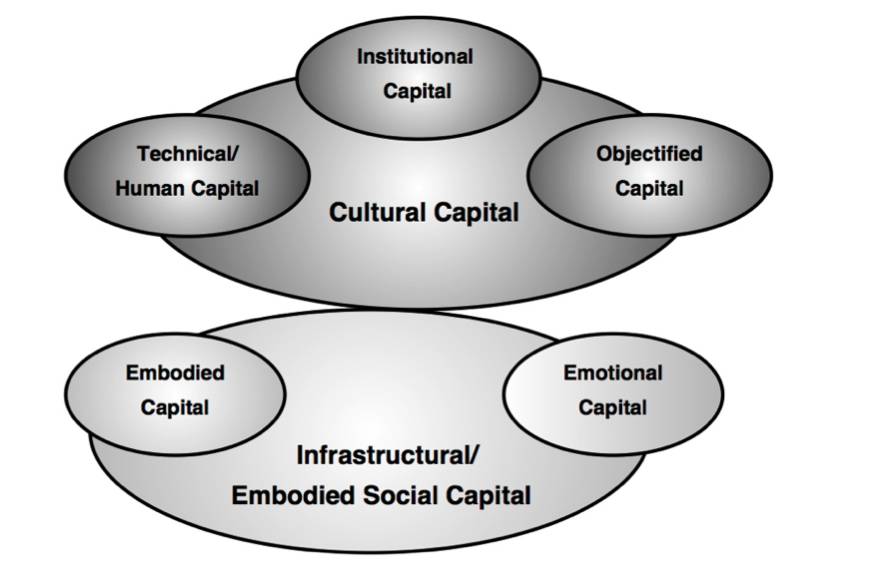
Figure 2: A disaggregated conception of social capital (Source: Phillips, forthcoming)
Social capital is, however, a “contested and congested concept” (Phillips, forthcoming), with a multiplicity of conceptions and little consensus as to the most desirable. It has also been criticised for making normative presumptions, such as people want to participate in social interaction and civic life (Portes 1998, 2000; Shorthall 2008). This is a criticism that Friedli (2012, p. 3) argues can also be applied to ABCD approaches which often implicitly assert the value of particular psychological attributes, such as “aspiration … [rather than] sufficiency and independence above solidarity”. Social capital approaches have also been criticised for facilitating the neglect of relations of power and thereby encouraging interpretations that in effect ‘blame the victim’ (e.g. Mohan and Mohan 2002; Harris 2001, Mayer and Rankin, 2002), or indeed champion the successful individuals or groups. Again, very similar criticisms are emerging around asset-based approaches more generally, with Friedli (2012, p. 2), for example, arguing that the asset based approaches have frequently acted to support “the attack on public sector provision, rather than addressing the health impact of corporate power”. A third area of criticism has been its effective instrumentalism of social life, and an associated neglect of its communicative and affective dimensions (e.g. Cloke et al 1995; Fine 1999, Anderson and Bell 2003).
For such reasons I have been personally reticent about using the concept of social capital, although recent has suggested that value in disaggregating the concept, recognizing that it may encompass and be supplemented by a range of assets including physical objects, ways of acting and being, formalised skills and intangible emotions and affects (see Figure 2). Focus group activities and discussions (Figure 3) clearly revealed the significance of this range of assets, as well as the important of what might be viewed as social capital assets.

Figure 3: Mapping assets in HealthWorks.
A second issue revealed in the research project Unearthing Hidden Assets was the value of considering assets as flows rather than a fixed, if changeable, stock. Whilst social capital is often seen as a vehicle for facilitating flows, particularly of information, it, and many other assets or forms of capital apart from economic capital, is rarely considered as flow. In the Unearthing Assets project, however, issues of asset flow became significant. So, for example, in 2013, the East End Community Development Alliance, which had been seen as an important vehicle in forming as well as assessing social capital, ceased to exist, raising questions as to what had happened to the social capital that had surrounded its operation. Had this social capital been simply ‘lost’, or had it been directed into alternative activities or transformed into other forms of assets? Mapping such flows and reconfiguration of assets, as well as the discovery of latent assets formed an emergent focus of the research being co-produced in association with HealthWorks and the Churches’ Regional Commission in the North East.
A third theoretical issue related to the concept of mapping assets. The term mapping within many studies of assets often refers to little more than creating an inventory of assets, although this is often created through participatory and creative ways that are themselves generative of social and cultural assets, such as senses and artefacts of collective belonging, identity and purpose. Whilst a central component of the current studies, coming from a geographical background, I also frequently made use of more geographical senses of mapping which sees maps as ways to perform and explore the spatialities of the socio-cultural assets, practices and relations. In all the AHRC studies listed in at the start to this section there has hence been a focus employing geographical senses of mapping, which has been undertaken through a variety of ways. Use, for example, has been made of geographical information system (GIS) software and gps tracking to map the social character and infrastructural assets of areas within the Unearthing Hidden Assets, Affect, affordance and connecting rural and urban communities and Revisiting the mid-point of British communities projects (see Figure 4). The last project also made considerable use of participatory and artistic methods of understanding and representing the spatialities of people’s senses of community (see Figure 5). In both cases, research adopted what has become identified as an iterative research methodology, whereby there are repeated movements between dimensions, moments or agents of research (see Phillips et al, 2014).
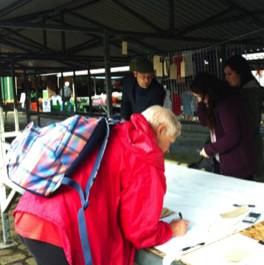
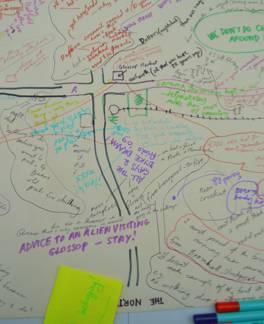

In the Revisiting the mid-point of British communities research project, semi-structured, mobile and psycho-social interviews were, for instance, used sequentially with issues raises in the initial two interviews being probed further in later interviews. The mobile interviews also demonstrated further moments of iteration as interviewees, and indeed interviewers, made reference to locational material encountered in the interview journeys to initiate, illustrate and refine interpretations (see de Leon and Cohen, 2005; Evans and Jones, 2011, p. 856; Jones et al., 2008; Kusenbach, 2003). Public mapping exercise and the development of a game based approach to community engagement and discussion also centrally employed notions of an iterative research method.
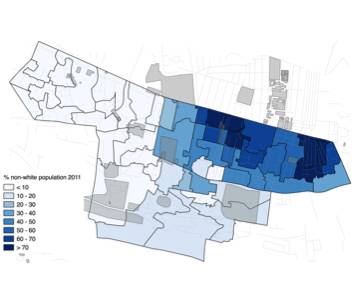
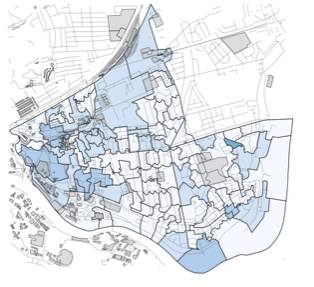

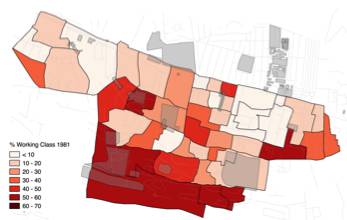
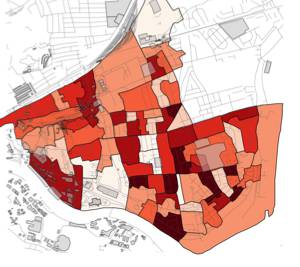
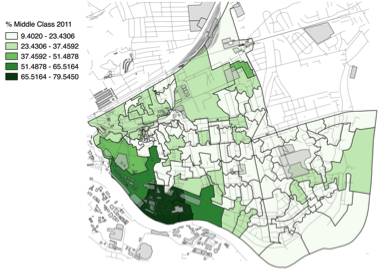
The game-based approach was particularly significant in relation to the project on mapping comparative approaches to asset mapping, with the game Glossopoly, created as part of the Revisiting the mid-point of British communities, research project being demonstrated at a workshop of project members and partner in London and employed with communities in the neighbourhoods of Kypselli and Dourgouti in Athens (See Figure 6). The rest of the discussion of asset mapping will very much focus upon the use of this game-focused approach.
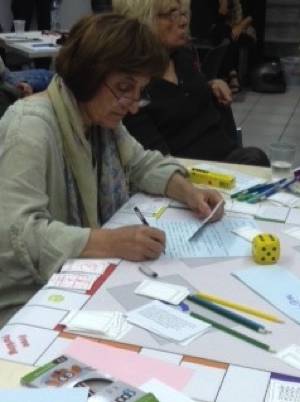
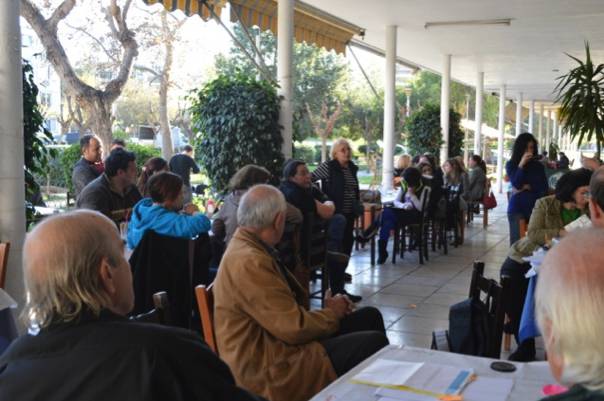
Asset mapping and Glossopoly
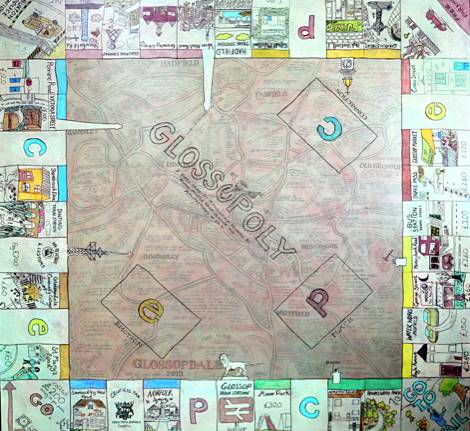
Figure 7b: Glossopoly board.
The use of games for more than just play has become widespread, with so-called gamification – the use of “game-play mechanisms for non-game applications: Muntean, C. (2011, p. 323) becoming widespread, and particularly employed in relation to advertising and education and training (e.g. see Kapp 2012; Terlutter and Capella 2013). Whilst much emphasis is currently placed on on-line and digital mobile gaming, in disciplines such as geography there has also been a longer running interest in the use of board, card and other physical object-based games in education and learning (e.g. Warburton and Madge, 1994), as well as the use of simulations, role play and other embodied games (e.g. Cloke, 1987; Dalton et al., 1971; Davidson et al., 2009; Livingstone, 1999; Maddrell, 1994, 2007; Walford, 1981). Rather less attention, however, has been paid to their use in research.
In the case of the Revisiting the mid-point of British communities research project, use of a game-based approached emerged initially as a way engage school aged children in discussions of the character of places within the town of Glossop and surrounding areas and how these children related to them. Groups of children were asked to create drawings of places they knew to populate a monopoly board of the town (Figure 7a). During this activity they were encouraged to talk about the places they were drawing in order to elicit their views on their places and initiate discussions amongst the children about the character of life in Glossop. Subsequently these drawings were incorporated in a painted representation (Figure 7b), which children used to play a game of monopoly (Figure 7c). It was, however, felt that this board could itself be used as a vehicle for iterative investigation of the project’s research themes. Cards were created that, on one side, represented the views of people in Glossop as expressed in the research project, expressed through words or images, and on the reverse contained a question related to these views and requiring people to express their own viewpoints, either in words, writing or images (see Figure 7d).
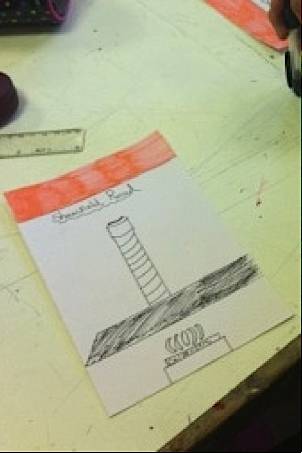
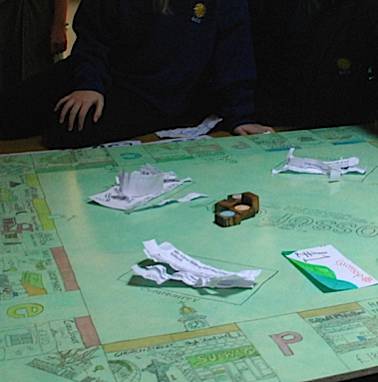

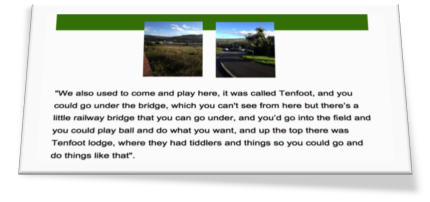
Over the course of two years, this concept developed into a game entitled Glossopoly which has been employed in a variety of contexts, including demonstration sessions at three AHRC Connected Communities Showcase events (London, Edinburgh and Cardiff) and a Localities Action Camp (Staffordshire). A form of the game was employed in the Unearthing Hidden Assets project and the game is currently being developed for use by a range of community groups as part of an AHRC Legacies research project: Evaluating the Legacy of Animative and Iterative Connected Communities Projects (AHRC s. It was also played as noted earlier, within this comparative mapping project in workshops in London and Athens.
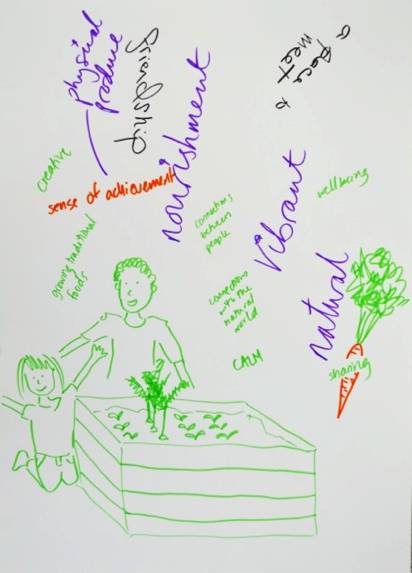
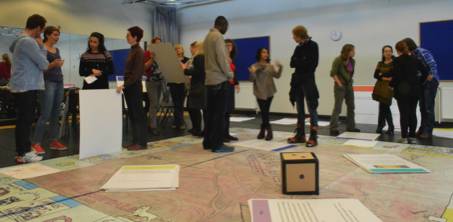
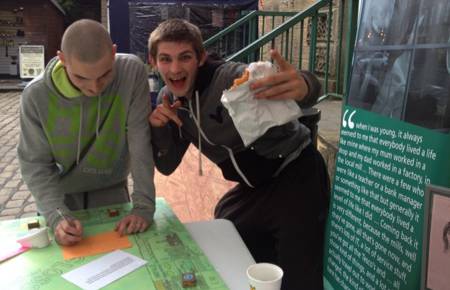
Figure 8a: Glossopoly in the Glossop Market.
The game has been used both as a means of facilitating engagement with research projects, being used, for example, at public events such as markets and carnivals (see Figure 8a) whereby it acts as a useful ice-breaker with conversations emerging as people take a few turns at playing the game. More substantive engagement with the game occurs when it has been used to facilitate group discussions. In such instances the game acts to provide a series of prompts for discussion, which, as in more conventional focus groups, can be recorded for further analysis, along with the written answers and drawings created by participants of the game (see Figure 8b). The game has also evolved to encompass more action focused discussions, through the incorporation of questions and activities which ask participants to think about potential solutions to issues raised in discussions. In the case of the game in Kypselli, for example, the game was re-designed to encourage participants to develop a project idea that would address multiple needs within the neighbourhood and involve a network of community and activist groups. Although not employed within these visits, a large-scale floor-based version of the game has also been developed which can be both played in a manner akin to the table-top version or employed methods associated with cultural animation (see Figure 8c).
Glossopoly and Contextual Conditions
The game Glossopoly initially emerged in a project focused on a very specific empirical and theoretical context. The project focused on a town that had been subject to a study (Birch, 1959) that played important roles in the emergence of community studies in Britain, not least through being incorporated in Frankenberg’s(1966) synthesis of a series of studies of community in Britain. Revisiting the mid-point of British communities sought to explore both how the character of community may have changed since the mid twentieth century but also how the study of community has changed over this period. In particular the study sought to explore how concepts of affect, affordance and connectivity could be used to understand the formation of senses of community and non-community. To aid this, Glossopoly was explicitly structured to address these theoretical concerns, with question cards incorporating research materials and questions connected to these conceptual concerns.
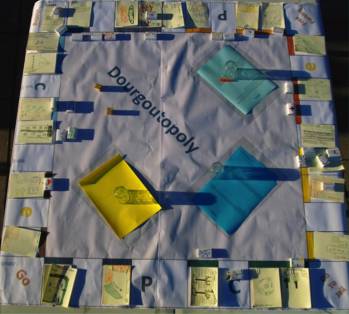
Figure 9b: Creating Dourgoutopoly.
However, as the preceding section has highlighted, Glossopoly has proved to extremely flexible, being employed in a variety of spatial contexts and for a range of different purposes. In part this flexibility has been achieved through conscious adaptation of the game to new contexts and purposes: in the visits to Athens, for example, site visits, informal interviews and secondary data sources were used to tailor the cards towards this new context and wishes of organisations involved in the comparative mapping project. Greater use of more open-style questions was also adopted to enable contextual concerns to emerge more directly. This illustrates how the game can be viewed as potentially self-contextualising in its adoption of an iterative approach whereby research materials and theoretical concerns are used as a means for stimulating further commentary and representations, which in themselves act as stimuli for further reflection and discussion. Playing games in series indeed allows material from early games to be directly incorporated into later games.
Partners and Types of Community Assets
Glossopoly was co-produced with one of the community partners in Revisiting the mid-point of British communities, namely High Peaks Community Arts. As discussed earlier, its genesis very much lay within this organisation’s art practice, although this is routinely combined with a concern for community development. Other organisations involved in the development and use of Glossopoly in this project include the Glossop and District Volunteer Centre and Glossopdale Community College.
As part of Evaluating the Legacy of Animative and Iterative Connected Communities Projects, a series of organisations have been invited to make use of Glossopoly. Discussions are also being held about potential use of the game within schools. In connection with this comparative mapping approaches project, an invitation was made by the Dourgouti Island Hotel project to run a workshop for residents and community groups in the Athens neighbourhood of Dourgouti. The workshop, included working with children and adults from the area to create a board with drawings of the area (see Figures 9a, 9b & 9c), as well as running a game with over 40 participants.
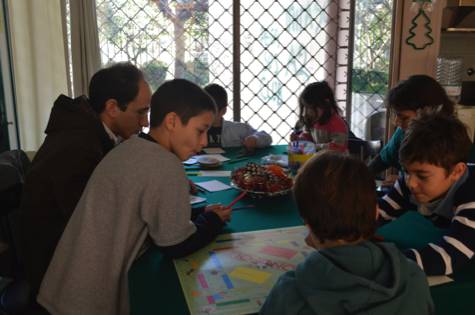

The Value and Outputs of Glossopoly
As noted above, Glossopoly has proved to be a highly flexible method for community engagement, research and asset mapping. A key element of this is its employment of an iterative approach where by people are required through the practice of play to engage with the views of other yet giving voice to their own interpretations. This provides as opportunities for refinement and deepening of interpretations, as well as engagement with others and opportunities to arrive at consensual understandings. It also, as outlined earlier, provides a mechanism for self-contextualisation, a feature very evident in the application of the game to two neighbourhoods in Athens. However, in both instances the contextualization was limited through constraints of time and language. Despite this, in both cases there were strong expressions as to the appropriateness of the research materials and questions to situations facing people in these Athens neighbourhoods. This raises the interesting question has to the degree to which people in seemingly quite different geographical and socio-cultural contexts may face very similar experiences and challenges. A challenge for further work using this game may be to explore such connections between communities.
Playing the game can generate a considerable amount of material for further analysis and discussion, particularly if there is audio and/or video recording of the game. Much of this material can be fed into further iterations of the game, although they can be used to develop other forms of analysis, interpretation and cultural expression. Further work is needed on how the game can be used to incorporate diverse and potentially conflictual perspectives, in terms of participants and/or in relation to the materials and questions contained within the game. The game has also been played with groups ranging from a couple of people playing as individuals through to, in the case of Dourgouti, over 40 people playing in groups. Whilst indicative of the games flexibility, further examination is needed on the dynamics and outcomes of the games when played with such different sized groups.
References
Anderson, C. and Bell, M. (2003) The devil of social capital: a dilemma of American rural sociology. Pp. 232-244 in P. Cloke ed. Country Visions (Harlow: Pearson Prentice Hall)
Bennett, T., Savage, M., Silva, E., Warde, A., Gayo-Cal, M., Wright, D., 2009. Culture, class, distinction. Routledge, London.
Birch, A.H., 1959. Small-town politics: a study of political life in Glossop. Oxford University Press, Oxford.
Cloke, P., 1987. Applied rural geography and planning: A simple gaming technique. Journal of geography in higher education 11 (1), 35-45.
Cloke, P., Phillips, M. and Thrift, N. (1995) The new middle classes and the social constructs of rural living. Pp. 220-238 in T. Butler and M. Savage eds. Social Change and the Middle Classes (London: UCL Press)
Dalton, R., Minshull, R., Robinson, A., Garlick, J. (1971) Simulation games in geography. Macmillan, London.
Davidson, J., Preez, L., Gibb, M., Nel, E., 2009. It’s in the bag! Using simulation as a participatory learning method to understand poverty. Journal of Geography in Higher Education 33 (2), 149-168.
de Leon, J. and Cohen, J. (2005) Object and walking probes in ethnographic interviewing. Field methods 17, 200-204.
Emejulu, A. (2013). ‘Searching for the State and the Market in American Community Development: Reflections on Editing Community Development in the Steel City’, Community Development Journal, 48(1): 158-162.
Evans, J. and Jones, P. (2011) The walking interview: methodology, mobility and place. Applied Geography 31, 849-858.
Fine, B. (1999) The developmental state is dead – long live social capital? Development and Change 30 pp. 1-19
Frankenberg, R. (1966) Communities in Britain. Penguin, Harmondsworth.
Friedl, L. (2012) ‘What we’ve tried, hasn’t worked’: the politics of assets based public health Critical Public Health 23 (2), 131-145
Harris, J. (2001) Depoliticizing Development: the World Bank and Social Capital (London: Anthem Press).
Jones, P., Bunce, G., Evans, J., Gibbs, H., Ricketts Hein, J., 2008. Exploring space and place with walking interviews. Journal of research practice 4.
Kapp, K. M. (2012). The Gamification of Learning and Instruction: Game-Based Methods and Strategies for Training and Education. (San Francisco: Pfeiffer)
Kretzmann, J. and McKnight, J. 1993. Building Communities from the Inside Out: A Path Towards Building and Mobilising a Community’s Assets. (Evanston, IL: Institute for Policy Research).
Kusenbach, M., 2003. Street phenomenology: the go-along as ethnographic research tool. Ethnography 4, 455-485.
Le Roux, B., Rousnet, H., Savage, M., Warde, A., 2008. Class and cultural division in the Uk. Sociology 42, 1049-1071.
Levitas, R. (2004) ‘Let’s Hear it for Humpty: social exclusion, the third way and cultural capital’ Cultural Trends Vol. 13(2), No. 50, June 2004, pp. 41–56
Livingstone, I. (1999) Role-playing planning public inquiries. Journal of geography in higher education 23 (1), 63-76.
MacLeod, A. and Emejulu, A. (forthcoming) Neoliberalism with a Community Face? A Critical Analysis of Asset-Based Community Development in Scotland, Journal of Community Practice
Maddrell, A., 1994. A scheme for the effective use of role plays for an emancipatory geography. Journal of geography in higher education 18 (2), 155-162.
Maddrell, A., 2007. Teaching a contextual and feminist history of geography through role play: women’s membership of the Royal Geographical Society (1892–1893). Journal of geography in higher education 31 (3), 393-412.
Mayer, M. and Rankin, K. (2002) Social capital and (community) development: a North/South perspective. Antipode 34 (4) pp. 804-808.
Mohan, G. and Mohan, J. (2002) Placing social capital. Progress in Human Geography 26 pp. 191–210.
Muntean, C. (2011) Raising engagement in e-learning through gamification. Procedings 6th International Conference on Virtual Learning ICVL (pp. 323-329). Available at: http://icvl.eu/2011/disc/icvl/documente/pdf/met/ICVL_ModelsAndMethodologies_paper42.pdf
O’Leary , Burkett, I. and K. Braithwaite., K. (2011. Appreciating Assets (Dunfermline: Carnegie UK Trust and IACD) (available from www.carnegieuktrust.org.uk)
Phillips, M. (forthcoming) Assets and affect in the study of social capital in rural communities, Sociologia ruralis.
Portes, A. (1998) Social capital: its origins and applications in modern sociology. Annual Review Sociology 24 pp. 1-24.
Portes, A. (2000) The two meanings of social capital. Sociological Forum 15 (1) pp. 1-12.
Savage, M. and Butler, T. (1995) Assets and the middle classes in contemporary Britain. Pp. 345-357 in M. Savage and T. Butler eds. Social Change and the Middle Classes (London: UCL Press).
Savage, M. (2003) A new class paradigm? British journal of sociology of education 24, 535-541.
Savage, M., Bagnall, G., Longhurst, B., 2005. Globalization and belonging. (London: Sage).
Schmuecker, K. (2008) Social capital in the North East: how do we measure up? (Newcastle upon Tyne: North East Social Capital Forum and Institute for Public Policy Research North)
Shortall, S. (2008) Are rural development programmes socially inclusive? Social inclusion, civic engagement, participation, and social capital: exploring the differences. Journal of Rural Studies 24 pp. 450-457.
Terlutter, R. and Capella, M. (2013) The gamification of advertising: analysis and research directions of in-game advertising, advergames, and advertising in social network game, Journal of Advertising, 42(2–3), 95–112.
Walford, R. (1981) Geography games and simulations: learning through experience. Journal of geography in higher education 5 (2), 113-119.
Warburton, G. and Madge, C. (1994) The snakes and ladders of research: using a board game to teach the pitfalls of undergraduate research design. Journal of geography in higher education 18 (2), 237-244.










